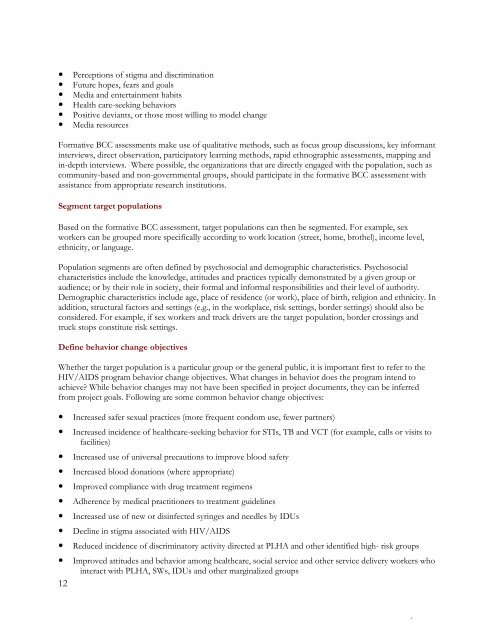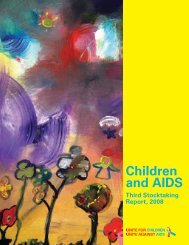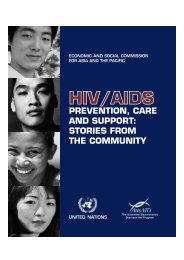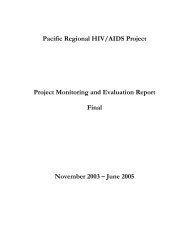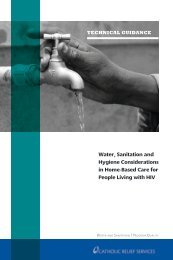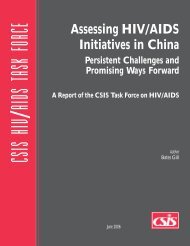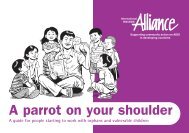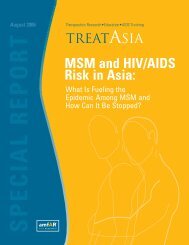Behavior Change Communication (BCC) for HIV/AIDS - hivpolicy.org
Behavior Change Communication (BCC) for HIV/AIDS - hivpolicy.org
Behavior Change Communication (BCC) for HIV/AIDS - hivpolicy.org
Create successful ePaper yourself
Turn your PDF publications into a flip-book with our unique Google optimized e-Paper software.
• Perceptions of stigma and discrimination<br />
• Future hopes, fears and goals<br />
• Media and entertainment habits<br />
• Health care-seeking behaviors<br />
• Positive deviants, or those most willing to model change<br />
• Media resources<br />
Formative <strong>BCC</strong> assessments make use of qualitative methods, such as focus group discussions, key in<strong>for</strong>mant<br />
interviews, direct observation, participatory learning methods, rapid ethnographic assessments, mapping and<br />
in-depth interviews. Where possible, the <strong>org</strong>anizations that are directly engaged with the population, such as<br />
community-based and non-governmental groups, should participate in the <strong>for</strong>mative <strong>BCC</strong> assessment with<br />
assistance from appropriate research institutions.<br />
Segment target populations<br />
Based on the <strong>for</strong>mative <strong>BCC</strong> assessment, target populations can then be segmented. For example, sex<br />
workers can be grouped more specifically according to work location (street, home, brothel), income level,<br />
ethnicity, or language.<br />
Population segments are often defined by psychosocial and demographic characteristics. Psychosocial<br />
characteristics include the knowledge, attitudes and practices typically demonstrated by a given group or<br />
audience; or by their role in society, their <strong>for</strong>mal and in<strong>for</strong>mal responsibilities and their level of authority.<br />
Demographic characteristics include age, place of residence (or work), place of birth, religion and ethnicity. In<br />
addition, structural factors and settings (e.g., in the workplace, risk settings, border settings) should also be<br />
considered. For example, if sex workers and truck drivers are the target population, border crossings and<br />
truck stops constitute risk settings.<br />
Define behavior change objectives<br />
Whether the target population is a particular group or the general public, it is important first to refer to the<br />
<strong>HIV</strong>/<strong>AIDS</strong> program behavior change objectives. What changes in behavior does the program intend to<br />
achieve? While behavior changes may not have been specified in project documents, they can be inferred<br />
from project goals. Following are some common behavior change objectives:<br />
• Increased safer sexual practices (more frequent condom use, fewer partners)<br />
• Increased incidence of healthcare-seeking behavior <strong>for</strong> STIs, TB and VCT (<strong>for</strong> example, calls or visits to<br />
facilities)<br />
• Increased use of universal precautions to improve blood safety<br />
• Increased blood donations (where appropriate)<br />
• Improved compliance with drug treatment regimens<br />
• Adherence by medical practitioners to treatment guidelines<br />
• Increased use of new or disinfected syringes and needles by IDUs<br />
• Decline in stigma associated with <strong>HIV</strong>/<strong>AIDS</strong><br />
• Reduced incidence of discriminatory activity directed at PLHA and other identified high- risk groups<br />
• Improved attitudes and behavior among healthcare, social service and other service delivery workers who<br />
interact with PLHA, SWs, IDUs and other marginalized groups<br />
12


